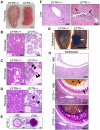Disruption of the CFTR gene produces a model of cystic fibrosis in newborn pigs
- PMID: 18818360
- PMCID: PMC2570747
- DOI: 10.1126/science.1163600
Disruption of the CFTR gene produces a model of cystic fibrosis in newborn pigs
Abstract
Almost two decades after CFTR was identified as the gene responsible for cystic fibrosis (CF), we still lack answers to many questions about the pathogenesis of the disease, and it remains incurable. Mice with a disrupted CFTR gene have greatly facilitated CF studies, but the mutant mice do not develop the characteristic manifestations of human CF, including abnormalities of the pancreas, lung, intestine, liver, and other organs. Because pigs share many anatomical and physiological features with humans, we generated pigs with a targeted disruption of both CFTR alleles. Newborn pigs lacking CFTR exhibited defective chloride transport and developed meconium ileus, exocrine pancreatic destruction, and focal biliary cirrhosis, replicating abnormalities seen in newborn humans with CF. The pig model may provide opportunities to address persistent questions about CF pathogenesis and accelerate discovery of strategies for prevention and treatment.
Figures




Comment in
-
Are pigs more human than mice?J Hepatol. 2009 Apr;50(4):838-41. doi: 10.1016/j.jhep.2008.12.014. Epub 2009 Jan 9. J Hepatol. 2009. PMID: 19231004 No abstract available.
Similar articles
-
Intestinal CFTR expression alleviates meconium ileus in cystic fibrosis pigs.J Clin Invest. 2013 Jun;123(6):2685-93. doi: 10.1172/JCI68867. Epub 2013 May 8. J Clin Invest. 2013. PMID: 23676501 Free PMC article.
-
A sheep model of cystic fibrosis generated by CRISPR/Cas9 disruption of the CFTR gene.JCI Insight. 2018 Oct 4;3(19):e123529. doi: 10.1172/jci.insight.123529. JCI Insight. 2018. PMID: 30282831 Free PMC article.
-
Bioelectric characterization of epithelia from neonatal CFTR knockout ferrets.Am J Respir Cell Mol Biol. 2013 Nov;49(5):837-44. doi: 10.1165/rcmb.2012-0433OC. Am J Respir Cell Mol Biol. 2013. PMID: 23782101 Free PMC article.
-
Lessons learned from the cystic fibrosis pig.Theriogenology. 2016 Jul 1;86(1):427-32. doi: 10.1016/j.theriogenology.2016.04.057. Epub 2016 Apr 21. Theriogenology. 2016. PMID: 27142487 Free PMC article. Review.
-
The porcine lung as a potential model for cystic fibrosis.Am J Physiol Lung Cell Mol Physiol. 2008 Aug;295(2):L240-63. doi: 10.1152/ajplung.90203.2008. Epub 2008 May 16. Am J Physiol Lung Cell Mol Physiol. 2008. PMID: 18487356 Free PMC article. Review.
Cited by
-
Lentiviral vector gene transfer to porcine airways.Mol Ther Nucleic Acids. 2012 Nov 27;1(11):e56. doi: 10.1038/mtna.2012.47. Mol Ther Nucleic Acids. 2012. PMID: 23187455 Free PMC article.
-
Integrative analysis of differentially expressed microRNAs of pulmonary alveolar macrophages from piglets during H1N1 swine influenza A virus infection.Sci Rep. 2015 Feb 2;5:8167. doi: 10.1038/srep08167. Sci Rep. 2015. PMID: 25639204 Free PMC article.
-
The cystic fibrosis of exocrine pancreas.Cold Spring Harb Perspect Med. 2013 May 1;3(5):a009746. doi: 10.1101/cshperspect.a009746. Cold Spring Harb Perspect Med. 2013. PMID: 23637307 Free PMC article. Review.
-
Chloride secretion by cultures of pig tracheal gland cells.Am J Physiol Lung Cell Mol Physiol. 2012 May 15;302(10):L1098-106. doi: 10.1152/ajplung.00253.2011. Epub 2012 Feb 24. Am J Physiol Lung Cell Mol Physiol. 2012. PMID: 22367783 Free PMC article.
-
Transport properties in CFTR-/- knockout piglets suggest normal airway surface liquid pH and enhanced amiloride-sensitive Na+ absorption.Pflugers Arch. 2020 Oct;472(10):1507-1519. doi: 10.1007/s00424-020-02440-y. Epub 2020 Jul 25. Pflugers Arch. 2020. PMID: 32712714 Free PMC article.
References
-
- Andersen DH. Am. J. Dis. Child. 1938;56:344.
-
- Quinton P. Physiol. Rev. 1999;79:S3. - PubMed
-
- Welsh MJ, Ramsey BW, Accurso F, Cutting GR. In: The Metabolic and Molecular Basis of Inherited Disease. Scriver CR, et al., editors. McGraw-Hill; New York: 2001. pp. 5121–5189.
-
- Rowe SM, Miller S, Sorscher EJ. N. Engl. J. Med. 2005 May 12;352:1992. - PubMed
-
- Riordan JR, et al. Science. 1989;245:1066. - PubMed
Publication types
MeSH terms
Substances
Grants and funding
LinkOut - more resources
Full Text Sources
Other Literature Sources
Medical

